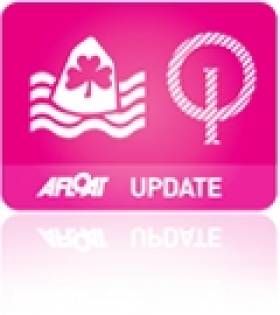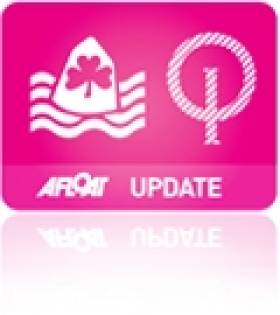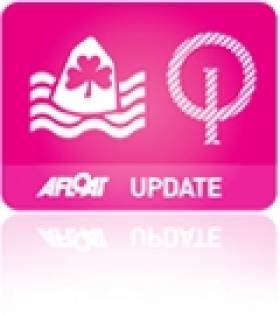Displaying items by tag: Sophie Browne
Four Top Ten Results Show Browne's Promise
#OPTIWORLDS – Irish Youth Sailor Sophie Browne of Tralee Bay SC and the Royal Cork YC has settled into her pre Optimist World Championships training regime at Napier Sailing Club on the beautiful Hawke's Bay on the East coast of New Zealand's North Island.
Having recovered from the long journey to the event and the jet lag, the 14 year old Kerry sailor has already shown some continuing form, following her top girl prize and 4th place overall at the Trofeo Ciutat de Palma in early December.
Sophie has finished The Pre Worlds Harken Invitational Optimist Regatta, at Napier Sailing Club, New Zealand taking 21st place overall from 214 starters representing 33 different countries from all over the World in yesterday's final rounds of the Harken Invitational Regatta at Napier, New Zealand.
The Optimist World Championships start tomorrow at the same venue. The sole Irish representative at the event, Sophie Browne, is among a very strong female line up for the start of tomorrow's Optimist World Championships which include, 4 very strong girls from Singapore who have shown good form and have performed well at the pre World's training event, a girl from the Dominican Republic, Justina Pacheco, who has also been very well regarded in the lead up to the World's and several other girls who may well dominate at this year's Worlds.
The invitational Harken Regatta which precedes the Worlds as a training event, at which the top New Zealand Optimist Sailors including Leonard Takahashi-Fry turned up to have a crack at the best Optimist Sailors from all over the World, got off to a challenging start for many of the lighter international sailors competing when the Race Officer set four races starting in 10 knots of breeze which shifted 90 degrees and built to 15 – 20 knots, with a nasty lumpy sea, before shifting back.
Sophie's experience from the Atlantic coast of County Kerry stood to her as she secured 4 top ten results out of the large fleet on the first day and at the conclusion of the Pre Worlds event finished 21st overall out of 214 boats participating.
Many teams have used the Invitational Regatta as a way to acclimatise their sailors to New Zealand sailing conditions on Hawkes Bay and the challenges of racing within a large fleet format where more than 200 boats were competing within a fairly tight area.
Francisco Ducasse from Chile was the overall leader after the first four races at the end of the first day and ended up 6th overall at the end of the two day event, while the Singapore girl Kimberly Lim was overall winner with her team mate Ryan Lo in second place and the Brazilian Rodrigo Luz in the third place on the podium. Justina Pacheco from the Dominican Republic finished 10th overall at the pre World's event
Sophie Browne was pleased with her performance ending in 21st place overall out of 214 boats in her training event in advance of the World Championships.
She will carry the Irish Flag at the opening ceremony in Napier tomorrow.
Ireland's Browne Part of Strong Female Line up at Optimist Worlds
#OPTI – In a further boost for Irish Optimist hopes at this year's world championships, Kerry's 14-year old Sophie Browne finished in the important top quarter of the pre-worlds event, taking 21st from 214 starters in today's final rounds of the Harken Invitational Regatta at Napier, New Zealand (See promo video below). The world championships start tomorrow at the same venue.
Browne, the sole Irish contender is among a strong female line up for the start of tomorrow's Optimist World Championships. The invitational Harken regatta precdes the worlds and it got off to a challenging start for many international sailors competing.
Many teams have used the Invitational Regatta as a way to acclimatise their sailors to New Zealand sailing conditions and the challenges of racing within a large fleet format where more than 200 boats were competing within a fairly tight area.
After a slight delayed start due the last minute sign up from a large number of sailors, the weather was perfect for a good day sailing, between 8 - 10 knots sea breeze. After race 2 the wind picked up to 15 - 18 knots, as predicted, and made some rough sailing.
214 sailors from 33 different countries headed out to sea this morning, all keen to get into it.
Provisional results show that the only male in Team Singapore won the first race. The second race was won by Chilean girl Franasco Ducasse and the third race was won by American sailor Marshall William who finished first in the last race with Chilean girl Franasco Ducasse the overall leader after four races.
The sailor holding the second position overall is another female, Justina Pacheco from the Dominican Republic.
The IODAI Optimist Trials concluded in Dun Laoghaire this weekend at the Mitsubishi Youth Regatta with a fine win for Sophie Browne. The Tralee Bay Sailor raced a consistent series with blinding boatspeed to pip long term leader Sean Donnelly (NYC). The purpose of the trials is to select teams to represent Ireland at the World, European and German Championships. The Royal Cork continued its recent history of fine results with 7 of the 18 available places being filled by club members.
By winning the trials, Browne has now taken up the option of travelling to New Zealand in December 2011 to represent Ireland at the Optimist World Championships.
The following sailors were selected by the trial process to represent Ireland at the European Championship which will be held in Portugal in July 2011: Sean Donnelly, HYC, Peter McCann RCYC, Harry Whitaker RCYC, Eoin Lyden RCYC, Jil McGinley RCYC Cliodhna Ni Shuilleabhain KYC and Megan Parker SSC
The team selected to travel to the German National Championships include Robert Dickson HYC , Daire Cournane KYC, Sean Waddilove Skerries SC, Richard Hogan HYC, Adam Hyland RSGYC, Ronan Cournane KYC, Sean Gambier Ross KYC and Fergus Flood HYC, Aoife Hopkins and Alacoque Daly Tralee Bay SC.
In addition 10 sailors were chosen for the Irish under 12 squad who will compete in the Optimist UK National Championships.
IODAI Trials 2011 Entries: 53 Races Sailed: 14 Discard: 3 Provisional Results| Series Place | Sail No | Fleet | Helm | M/F | Prize Age | Club | Series Points |
|---|---|---|---|---|---|---|---|
| 1 | 1368 | Senior | Sophie Browne | F | 14 | TBSC/RCYC | 29.71 |
| 2 | 1438 | Senior | Sean Donnelly | M | 14 | NYC | 31 |
| 3 | 1439 | Senior | Peter McCann | M | 14 | RCYC | 46 |
| 4 | 1440 | Senior | Harry Whitaker | M | 14 | RCYC | 50 |
| 5 | 1441 | Senior | Eoin Lyden | M | 14 | RCYC/BSC | 68.29 |
| 6 | 1355 | Senior | Robert Dickson | M | 13 | HYC | 98 |
| 7 | 1410 | Senior | Daire Cournane | M | 13 | RCYC/KYC | 100 |
| 8 | 1433 | Senior | Jil McGinley | F | 14 | RCYC | 101 |
| 9 | 1437 | Senior | Sean WADDILOVE | M | 14 | SSC/HYC | 103 |
| 10 | 1442 | Senior | Cliodhna Ni Shuilleabhain | F | 13 | KYC | 110 |
| 11 | 1375 | Senior | Richard Hogan | M | 13 | HYC | 111 |
| 12 | 1413 | Senior | Adam HYLAND | M | 14 | RstGYC | 118 |
| 13 | 1411 | Junior | Ronan Cournane | M | 12 | RCYC/KYC | 125 |
| 14 | 1443 | Senior | Sean Gambier-Ross | M | 14 | KYC | 134 |
| 15 | 1315 | Senior | Fergus Flood | M | 13 | HYC | 135 |
| 16 | 1407 | Senior | Conor O'Beirne | M | 13 | RStGYC | 148 |
| 17 | 1436 | Senior | Daniel RAYMOND | M | 13 | NYC | 161 |
| 18 | 1341 | Junior | Ewan MCMAHON | M | 12 | HYC | 174 |
| 19 | 1425 | Senior | Douglas Elmes | M | 13 | RCYC/WHSC | 177 |
| 20 | 1335 | Senior | Scott Levie | M | 14 | LDYC/KYC | 179 |
| 21 | 1348 | Senior | Megan Parker | F | 13 | SSC | 183 |
| 22 | 1154 | Senior | Ciaran Finnegan | M | 13 | WHSC | 203 |
| 23 | 1305 | Senior | Sandy APLIN | M | 13 | RStGYC | 215 |
| 24 | 1298 | Senior | Bill Staunton | M | 14 | SSC | 218 |
| 25 | 1361 | Senior | Aoife Hopkins | F | 13 | HYC | 252 |
| 26 | 1369 | Senior | Adam D'ARCY | M | 13 | RCYC | 252 |
| 27 | 1340 | Senior | Alacoque Daly | F | 13 | TBSC | 264 |
| 28 | 1307 | Senior | Anna Kelly | F | 13 | RCYC | 267 |
| 29 | 1234 | Senior | Mark Bolger | M | 14 | RSGYC/BSC | 272 |
| 30 | 1422 | Senior | Chloe Eggers | F | 14 | RStGYC | 279 |
| 31 | 1349 | Senior | Conor KNEAFSEY | M | 14 | NYC | 283 |
| 32 | 1302 | Junior | Harry Craig | M | 12 | RStGYC | 289 |
| 33 | 1012 | Junior | Niamh Henry | F | 12 | RStGYC | 297 |
| 34 | 1412 | Senior | Eva DONWORTH | F | 15 | RCYC/BSC | 330 |
| 35 | 1337 | Senior | Donagh O'Buachalla | M | 14 | TBSC | 330 |
| 36 | 1372 | Junior | Isabelle Delamer | F | 12 | HYC | 349 |
| 37 | 1314 | Senior | Alexandra Walsh | F | 14 | RStGYC | 351 |
| 38 | 1243 | Senior | Charley Breen | F | 13 | RCYC | 357 |
| 39 | 1225 | Senior | Peter Healy | M | 14 | KYC | 358 |
| 40 | 1229 | Senior | Maeve O'Sullivan | F | 15 | RCYC | 390 |
| 41 | 1353 | Senior | Thomas Moore | M | 14 | SSC | 393 |
| 42 | 1421 | Junior | Evie Byrne | F | 12 | NYC | 395 |
| 43 | 1415 | Senior | Caitlin Waters | F | 15 | RStGYC | 400 |
| 44 | 1217 | Junior | Rebecca O'Shaughnessy | F | 12 | RCYC | 414 |
| 45 | 1360 | Senior | Nicole Hemeryck | F | 13 | NYC/ HYC | 416 |
| 46 | 1148 | Junior | Eoghan O'Buachalla | M | 12 | TBSC | 417 |
| 47 | 961 | Senior | Claire O'Sullivan | F | 13 | RCYC | 421 |
| 48 | 1266 | Junior | Scott O'Sullivan | M | 12 | KYC | 438 |
| 49 | 1408 | Junior | Kate Lyttle | F | 12 | RStGYC | 465 |
| 50 | 1402 | Senior | Lucy McCutcheon | F | 14 | RStGYC | 470 |
| 51 | 1250 | Senior | Anna Potterton | F | 13 | WHSC/HYC | 497 |
| 52 | 1247 | Senior | Conor Totterdell | M | 15 | NYC | 542 |
| 53 | 1414 | Senior | Alexander GILLETT | M | 13 | RStGYC/LDYC | 594 |































































